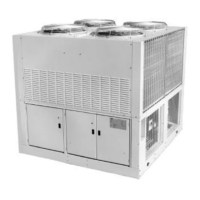16 IOMM ACZ/AGZ-1
Liquid Lines
Liquid lines are generally sized for 1 to 2 degree F line losses or their equivalent in pressure drop.
Actual selection can vary based upon the pressure drop expected from refrigerant specialties such as
solenoids, refrigerant driers, valves, etc. piping lifts or risers and the amount of condenser sub-cooling
expected.
The principal concern in sizing and routing liquid lines is assurance that liquid is present in the line at
start-up of the compressor, and that liquid and not vapor is available at the inlet to the expansion
valve during system operation.
Liquid may not be available in a liquid line at start-up if:
1. The solenoid valve is located adjacent to the condenser or condensing unit; remote from the
expansion valve.
2. An excessive length of liquid line is located in a heated ambient and the application permits
migration of the refrigerant to a cold air-cooled condenser.
3. Liquid refrigerant is permitted to gravitate from the liquid line to the condenser because of the
relative location of components.
4. Liquid line solenoid valves should be located adjacent to the expansion valve with possibly only
a sight glass interposing the two.
In the event 2) or 3) above are possible, the application should include a check valve at the condenser
end of the liquid line. The check valve should be a low pressure drop valve. The line between the
check valve and the solenoid valve can be comparable to a pressure vessel and as the line becomes
heated refrigerant trapped in the confined space will increase in pressure. The check valve should
include a pressure relief devise, relieving from the line side to the condenser side of the circuit. The
relief can be sized for a pressure differential from 80 to 180 psi, but not more than 180 psi, and should
be auto-resetting as the pressure is relieved.
CAUTION: The liquid line should not include a check valve unless the line also includes an
automatic resetting pressure relief device.
CAUTION: If the relief device being used is relieving from the line to the condenser side of the
check valve, the maximum desirable pressure differential with R-22 refrigerant is 180 psi. With
134a, 100 psi.
If liquid lines are short, they may be of smaller diameter than the size indicated in the ASHRAE
Refrigerant Handbook, 1998 Edition, Chapter 2, Tables 3 or 4. As indicated above, the designer must
size the liquid line to assure that pure liquid will reach the inlet of the expansion valve. If the
condenser is sized to produce 10ºF of subcooling, and each degree represents 3.05 psi with R-22 (or
2.2. psi with R-134a), the liquid line and its refrigerant specialties may have pressure losses totaling 10
x 3.05 psi (or 10 x 2.2) and still satisfy the objective of believing pure liquid to the expansion valve.
In calculating the pressure losses, or gains, note that each foot of rise in a liquid line results in an
approximate 0.5 psi loss. Thus a 10 foot rise represent 5 pounds per square inch loss in refrigerant
pressure, or the equivalent of 1.6ºF subcooling with R-22. Total line losses will include values for line
friction, equivalents for valves and elbows and pressure losses from manufacturers’ catalogs for
driers, solenoids, sight glasses, etc.
In estimating condenser subcooling, note that saturated condensing pressure should be read, or
estimated, at the same point in the system where the liquid refrigerant temperature is obtained. That
condensing pressure is not the discharge pressure read at the compressor outlet. Because it is less,
the net value of subcooling will be lower than might otherwise be assumed.

